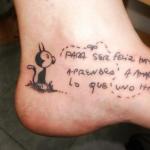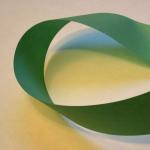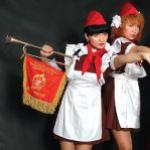Hairdressing scissors and their types. Types of scissors and their purpose Regular scissors
Today, the hairdressing craft rather falls within the framework of art; there are so many subtleties and techniques that exist in this profession. And, of course, there is no need to explain what effect a trip to the hairdresser has on your mood. The main thing in this whole action is the master’s hands, but no less important is the tool the master uses. This comprehensive introduction begins a series of instructions about hairdressing scissors or hair scissors.
Let's start with the fact that all scissors according to their functions are divided mainly into straight scissors and thinning scissors.
1.Straight scissors– available with and without micro-notches.
Scissors with micro-notch They have blades with micro-teeth notches on them, which are visible upon close examination. With the help of this notch, strands of hair do not slide off the sharp surface, but are held at the moment the blades close.
The micro-notch can be one-sided (on one blade) or two-sided (on two blades).
These scissors are used for men's and women's haircuts and for cutting dog hair.
2. Scissors without micro-notches either belong to the category of cheap scissors, or are specially made in this format and are intended for tangential cutting.
Cheap scissors are correspondingly cheap, they have rough plastic rings for the fingers, they are often not centered, the metal is soft, so the blades quickly become dull.
Special scissors without micro-notches are the complete opposite. The blades and rings are smooth, durable, the blades meet without play or crosshairs, and are very sharp. These scissors are used to perform complex women's haircuts when, when cutting hair, the blades do not close, but simply move along the line and achieve a petal effect of the strands. For comparison, to make it clear what the cutting process looks like with such scissors, they also cut packaging film for flowers without closing the blades, cutting the entire plane with a quick, precise movement.
3.Thinning scissors They differ from straight ones in that one or both blades are turned into a comb with a cutting surface. Thinning is performed in order to give the haircut more naturalness, while the hairstyle does not look cut “to the line”.
Thinning scissors are also used at the roots of the hair to add volume to the hairstyle.
What separates man from ape is that man can give objects and their parts names and then convey these names to others through speech, conveying his ideas to them. There is no longer any need to carry scissors with you and point your finger saying this needs to be sharpened here, but here it needs to be made thinner. In any professional approach There's always terminology. And this is what separates a professional from an amateur.
To some extent, there is a slight scatter and confusion regarding what and how to call it, caused by the fact that there are three groups of influence and everyone three groups this terminology is different. Sharpeners, craftsmen and technologists. The first is sharpeners, I was once one of them. Wow... no matter how we named the various elements, but in our team the terms were well-established and when hairdressers came to us, we did not always understand each other, since they called the same parts with different words.
The third and smallest group to which I now belong are technologists or customers who communicate with factories and order tools and create lines of hairdressing tools. In our country, the need for terminology is caused by a vital necessity, and we must know how and what is called in at least two languages. And here is part of our terminology in Russian:
Why is only part of the terminology posted? Here is the terminology related to consumer properties, but there is a part of the terminology that relates to methods of production and processing that will be of little interest to you. But by the way, I will say that to produce 1 scissors you need to do 120-140 operations and often for one operation you need a separate machine and in the factory itself, rest assured, there are 120-140 names for operations and for places that improve these operations.
What to do when the terminology is different? In any case, if you remember our names, then it will be easier for you to explain to others what you want from them, as opposed to what if you didn’t even know what they were called.
And based on the degree of immersion in the topic, a hairdresser has 7-10 terms in his vocabulary, a sharpener has 20-30, and a technologist has 100 or more. Who should learn terminology from whom?
But there is also terminology for using scissors, for example, a master can be aware and feel varying degrees sticking or looseness or sharpness. He works with them, and he feels it during multiple cycles of convergence and divergence of blades, and he knows this better than a sharpener or a technologist.
I once saw a program on TV about a woman who sorted foil or paper by touch by thickness. She found the difference between 0.05 mm and 0.1 mm. Others did it with micrometers, but she did it by touch. She did not have any superpowers, but acquired this skill over the years by repeating the same operation many times.
Many masters who have worked a lot in the industry begin to feel the slightest changes in stroke and the resulting friction in the joint.
Do you know that the Chukchi have more than 20 names for snow? He sees him every day. But we Europeans can only say that it is sticky or loose, but the Chukchi have a name for loose snow that was slightly frozen at sunrise after which a thin crust formed on it, which has oh, what a meaning, and he calls this snow in one word - after all, the sled will now travel across the tundra in a completely different way, at a different speed, and it will reach the pasture faster.
Returning to our masters, I am sure that there is a user terminology and in it I will tell you about what the hairdressers told me when I worked as a sharpener, how they handed over the tool to me for sharpening and in what words they described what was wrong with the stroke and what was wrong with tool. But more on that in the next article.
Everyone - always sharp and safe work!
ZAT (Dnepr, Ukraine)
March 23, 2020
March 20, 2020
Use this information if you think you have cause for concern. And if it turns out that they do exist, then immediately contact your family doctor for consultation:

P.S. Share this table with your family, loved ones and friends. Perhaps for some it will clarify unclear issues related to coronavirus or (if everything is already so bad) it will convince them to see a doctor rather than self-medicate...
March 15, 2020
Created 02/25/20, last update - 02/25/20
March 10, 2020
ZAT (Dnepr, Ukraine)
March 05, 2020
Everyone Have a good day and safe internet!
YouTube...
Photo by Gerd Altmann from Pixabay
ZAT (Dnepr, Ukraine)March 01, 2020
| Temperature color chart for carbon steel:* | |
| Bright yellow | 1100° C |
| Dark yellow | 1040° C |
| Orange-yellow | 980° C |
| Orange | 930° C |
| Red-orange | 870° C |
| Bright red | 820° C |
| Red | 760° C |
| Dull red | 650° C |
| Reddish with gray tint | 590° C |
| Gray with red tint | 540° C |
| Dark grey | 430° C |
| Gray blue | 320°C |
| Light blue | 310° C |
| Blue | 300°C |
| Dark purple | 280° C |
| Violet | 270° C |
| Brown purple | 260°C |
| Brown | 250° C |
| Light brown | 240° C |
| Golden yellow | 230°C |
| Light yellow | 220° C |
| Straw | 210° C |
| Light straw | 200° C |
* Depending on the composition and thermal conductivity of the steel, the temperature values for individual tarnish colors may differ slightly from those given in the table.
You should also remember that:
1. The shade of tarnish is affected by the heating rate of the steel, exposure time, lighting, the presence of traces of oil or chemicals, reagents, air or gas environment, etc.
2. For alloy and stainless steels that are more resistant to oxidation in air, tarnish colors begin to be noticeable at higher temperatures.
3. The thickness of the oxide film increases with increasing heating time - this should be taken into account if the tool or part is subjected to constant or periodic heating. Therefore, steel that has been kept at a temperature of 200° C for a long time (with constant or periodic heating) may turn brown or purple. Although the temperature of its heating never exceeded that required to obtain a light straw-colored tarnish.
4. Increasing the thickness of the oxide film may cause the joint tools to malfunction.
That's all for now.
Sources: wikipedia.org, threeplanes.net, avventurosamente.it
P.S. Don't forget to subscribe to my channel at YouTube...
Created 09/27/10, last updated 02/25/20
Created 10/03/10, last updated 02/28/20
February 25, 2020
P.S1. The Blog about Sharpening previously published an article "". Read it, it’s interesting and resonates with the topic of today’s article.
P.S2. Subscribe to my channel at YouTube...
February 20, 2020
Which sterilizer to choose for manicure and pedicure instruments? How to choose a dry heater or an autoclave? I am sure that this article and the comments to it will help the reader make this difficult choice. If you haven’t found the answer to your question, then ask it in the comments (don’t forget to introduce yourself who you are and where you’re from)...
Sterilization is carried out with the aim of destroying all pathogenic and non-pathogenic organisms and spore forms - after it, microbes can be found on only one out of a million infected instruments, while after disinfection - on five, ten, a hundred or more.
In nail salons, hairdressing salons and beauty salons, physical (steam, air, heated glass beads) and chemical (chemical solutions) methods are usually used for sterilization. The need for sterilization is regulated by state, republican and local laws, norms and rules, which can and should be applied, but which may differ in different countries. All the above-mentioned sterilization methods, more or less common in the beauty industry, are discussed below in detail.
AIR STERILIZER
Tin shears are widely used for cutting steel sheets of different thicknesses. With their help, workpieces with high linear dimensional accuracy are obtained. Since the processing occurs in a cold way, overheating of the edge and the formation of scale are eliminated.
There is a huge variety of scissors - from powerful stationary equipment to lightweight and mobile hand tools. When choosing, you need to take into account the specifics of the application, the intensity of operation and the nature of the tasks. No one will purchase a hydraulic guillotine for household work, while even the best manual model will not cope with the production load of a metalworking plant.
When choosing, the following factors are important:
- maximum dimensions of the metal being cut (thickness, width);
- nature of processing (straightforward, curvilinear);
- material for making knives (these must be hard tool alloys);
- electric motor power (if available);
- functionality, ability to adjust cutting depth, technical characteristics.
What types of scissors are there?
Let's look at the main types of scissors and their capabilities:
- Manual for household use. They are used exclusively for cutting thin sheet metal, most often tin, sometimes wire. Externally similar to ordinary scissors. They are driven by human muscular power and can be used for both straight and curved cutting. Scissors on the market different designs, which differ in the shape of the cutting edges and other parameters.
- Guillotine. High-performance stationary equipment used in industrial workshops and repair shops for straight cutting. With its help, even thick metal (up to 25 mm) can be successfully chopped. The required gap is set, the sheet is placed under special clamps. Two knives (one movable, the other not) interlock, resulting in a high-quality cut across the entire width. There are both electric and lever (manual) models that operate autonomously.
- Nibblers. Serve for complex figured cutting. Create an even and clean line cutting without deformation and chips. They are characterized by high maneuverability and a minimal turning radius. The working area is clearly visible; you can even start cutting from the middle of the sheet.
- Combined press shears. Convenient, multifunctional, productive. They can work not only with sheet metal, but also with rolled profiles. In addition, they are used to make cuttings in blanks.
Additional Information
The hairdresser uses special scissors to cut hair. Hairdressing scissors (Fig. 1) differ from the usual ones used in everyday life, with a more elegant finish, the best varieties steel used for their production, as well as the highest precision grinding of working surfaces.
Rice. 1 Types of scissors: a) hairdressing scissors, b) serrated
The scissors consist of three parts: two identical halves and a screw holding them together. Each half of the scissors consists of a blade, a lever and a ring. The blade of the scissors has ends, a sting and working surfaces (the rubbing sides of the blade). The blade is the main part of the scissors. It is customary to distinguish only two types of scissors - straight (Fig. 7, a) and serrated (Fig. 7, b), however, each of them has several modifications. So, straight scissors come with sharp and blunt ends, with a tail at the ring and without a tail. They also differ in length - average length hairdressing scissors 170 - 180 mm.
Toothed scissors differ in the height of the tooth, its shape, and also in the fact that some have teeth on two blades, while others only on one (see Fig. 7, b).
The main purpose of straight scissors is to trim scalp hair, beards and mustaches. They cannot be used for other purposes.
Serrated scissors are used for thinning hair. If the hair is very thick, it needs to be thinned (cut) gradually towards the ends, i.e., filed. When rare and fine hair There is no need to use serrated scissors.
Basic (straight) - used to cut hair and straighten strands.
For a straight cut (with a micro-notch on one or two blades to prevent hair from slipping, to reduce errors in cutting, sharpening angle 55-60°).
For a sliding cut - slicing (with convex (convex) sharpening, sharpening angle 30-45°).
Scissors with thin ends - for edging and precise cutting.
The blades of straight scissors are different lengths and this determines the ease of execution different types haircuts:
Classic - universal with a linear cutting blade (14-15 cm).
Short blades - for coarse hair(Asian type) or for trimming mustaches and beards (10-12 cm).

Long blades - for complex haircuts long hair(15-17.5 cm).
Avant-garde - with a curved blade, intended only for slicing.

Blade - with a linear blade, with a special cutting edge design.
Single-sided and double-sided thinning scissors - to give the haircut the effect of volume, smoothness, soft gradation of strands:
With teeth of different widths - they add volume to the hairstyle and create a stepped effect.
With prism-shaped teeth - they make an accurate cut line, but slightly soften the contour.
Flag ones - have one blade either classic or with two teeth, and the other with a figured nozzle. These scissors cut and mill at the same time. As a result, you can get either a strand with a thinning at the end according to the blade pattern, or voluminous hairstyle with long or short strands of hair, interesting texture.

Hot scissors are ordinary scissors that are enclosed in a plastic case. Electrical conductors pass through this body, which are connected to the blade of the scissors using special electrodes. From the scissors there are wires to a stationary device with a control panel, with the help of which the master selects the temperature for heating the scissors.
Scissors device.

Rice. 5 The structure of the scissors: 1 - ring; 2 -- lever; 3 -- working surface; 4 - sting; 5 --end; 6 -- canvas; 7 -- fastening screw
Let's look at the structure of scissors. The scissors consist of three parts: two identical halves and a fastening screw 7. Each half of the scissors consists of a blade 6, a lever 2 and a ring 1. The blade of the scissors has an end 5, a tip 4 and a working surface 3 (one of the rubbing sides of the blades). The fastening screw regulates the working stroke of the scissors. If the screw is very loose, then the scissors do not cut, but rather break a strand of hair; If the screw is too tight, the scissors will be difficult to open and close. The blade is the main part of the scissors.
Holding techniques.

Scissors are held in right hand. At the same time, they are turned so that the head of the screw holding the two halves of the scissors together faces the client. To do this, insert into the upper ring ring finger, and at the bottom - the thumb. You should not insert your fingers deeply into the rings of the scissors, as in this case it will be inconvenient to work with them. Typically, the rings of the scissors are placed on the first phalanges of these fingers, with the middle and index fingers on the upper lever of the scissors. Thus, all fingers of the hand, except the little finger, take part in working with scissors. But this is only if the scissors do not have a tail on the ring; if there is such a tail on the scissors, then the little finger is located on it and, therefore, all fingers of the hand are involved in the work. The main load is performed by the thumb, and the rest serve as a support.






